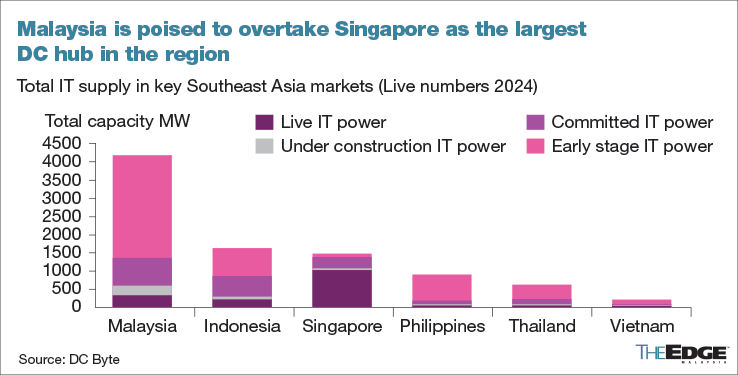
Bloomberg filepix for illustration purpose only.
KUALA LUMPUR (Oct 2): RHB Research said Malaysia is poised to become the largest data centre (DC) hub in the region, with Johor as the new DC capital, bringing online at least 1.4 gigawatt (GW) over the next three years, while it shrugs off concerns about potential oversupply.
In a thematic report on Wednesday, the house said Malaysia’s DC inventory could be 10 times what the industry built over the past 20 years, positioning it significantly ahead of Singapore, which is constrained by land scarcity and environmental regulations.
RHB said Malaysia is expected to account for over 50% of the total information technology (IT) load in the top-five Southeast Asian markets, with Johor’s DCs comprising the majority at over 2.3GW.
Citing DC Byte, the report said that total IT load for Malaysia was at about 4GW (3Q2024), which comprised 344 megawatt (MW) live supply; 241MW of supply under construction; 767MW committed supply, and 2,829MW in early stages of development.
“The data suggests that more than 1GW of supply (defined as under construction and committed supply) are expected to come on stream over the next two years, while nearly 3GW are in the developmental stages (announced but pending various approvals including land, power, etc), and would progressively be commissioned over the next three- to five years.”
RHB said its preferred DC stock picks are Telekom Malaysia (KL:TM), Singtel, Tenaga Nasional (KL:TENAGA), YTL Power International Bhd (KL:YTLPOWR), Gamuda Bhd (KL:GAMUDA), Sunway Construction Group Bhd (KL:SUNCON), IJM Corporation Bhd (KL:IJM), Sime Darby Property Bhd (KL:SIMEPROP) and Mah Sing Group Bhd (KL:MAHSING).
RHB noted that the domestic DC landscape has gotten a “big” shot in the arm, with hyperscalers committed to setting up their cloud regions, as in investments act as a strong funnel for growth, adding to the investments by wholesale co-location providers.
“We see the strong commercial proposition of DCs spawning more M&As (mergers & acquisitions), and/or strategic partnerships across multiple stakeholders, fuelling an expansion in transaction multiples. Agricultural land owners are warming to diversification opportunities, in light of declining yields from traditional crops,” it added.
Addressing concerns over supply glut, water supply
RHB said a supply glut should not be a concern, given the accelerated adoption of artificial intelligence (AI), which is driving demand for scalable DC infrastructure and increasing investments in graphics processing units (GPUs) to manage complex AI workloads.
Additionally, data compliance and residency requirements, modular expansion by DC owners, and the retrofitting of older facilities will further mitigate the risks of oversupply, it said.
“We see DC investments as a catalytic enabler to raise Malaysia’s economic complexity and move up the technology ladder. The timely development of the Johor-Singapore Special Economic Zone (JS-SEZ) is a potent stimulus, providing a secure ground for DCs to thrive,” it added.
Meanwhile, RHB said the strain on power grids and water are “well documented”.
It noted that the bulk of water consumed by DCs (approximately 40% of overall energy-related cost) is used for cooling systems, which comprises cooling towers, chillers, heat exchanges, pumps and computer room air handler (CRAH) units.
RHB noted that Ranhill SAJ Sdn Bhd has received applications for 439.67 millions of litres per day (MLD) of water between 2024 and 2035 from DCs, but can only support 316.38MLD, indicating a 28% deficit.
National Water Services Commission data shows that Johor’s and Selangor’s water reserve margins of 16.8% and 13.4% are sufficient to support additional demands, with plans to increase these margins to 17.7% by 2030 and 25% by 2029, and Sedenak Tech Park (STeP) has adequate water supply for cooling up to 20MLD.
- Xi's showdown with Li Ka-shing threatens China’s pro-business push
- Tan Kean Soon steps down as T7 Global executive deputy chairman, board says no operational impact
- Company auditor loses RM1.29m to investment scam
- Huawei posts surprise loss after aggressive tech research
- Perak emerges as Malaysia's No 1 sweet corn producer


